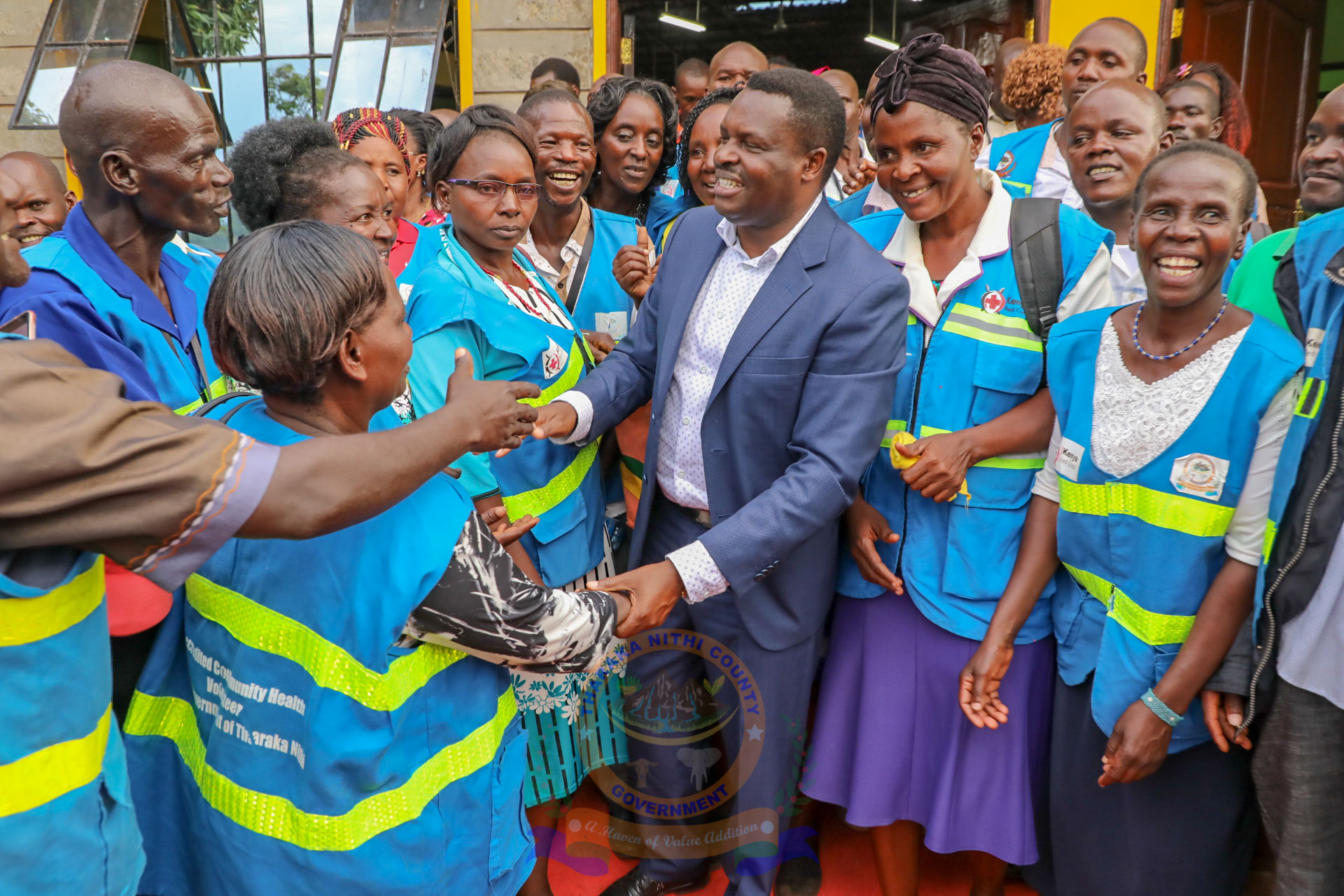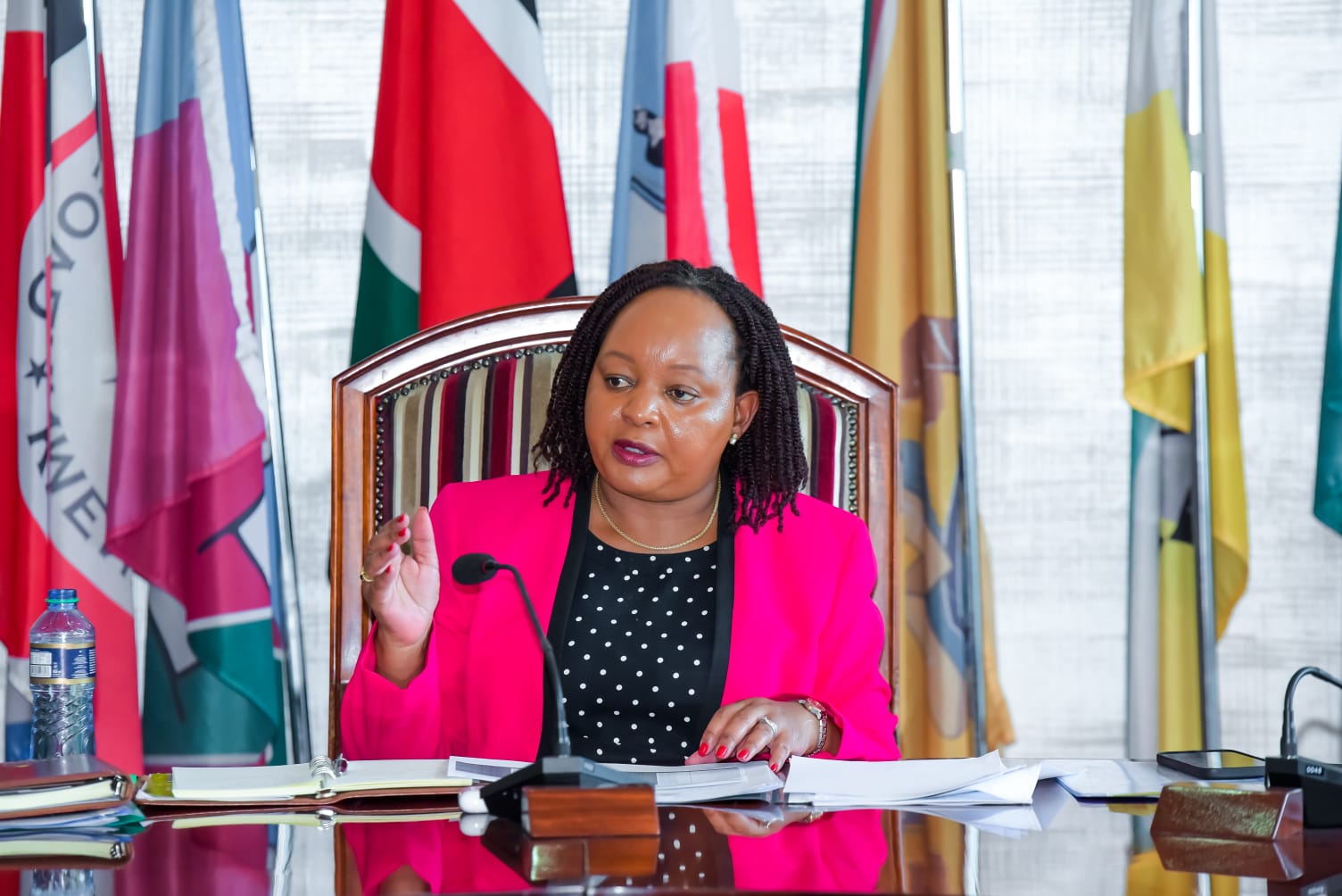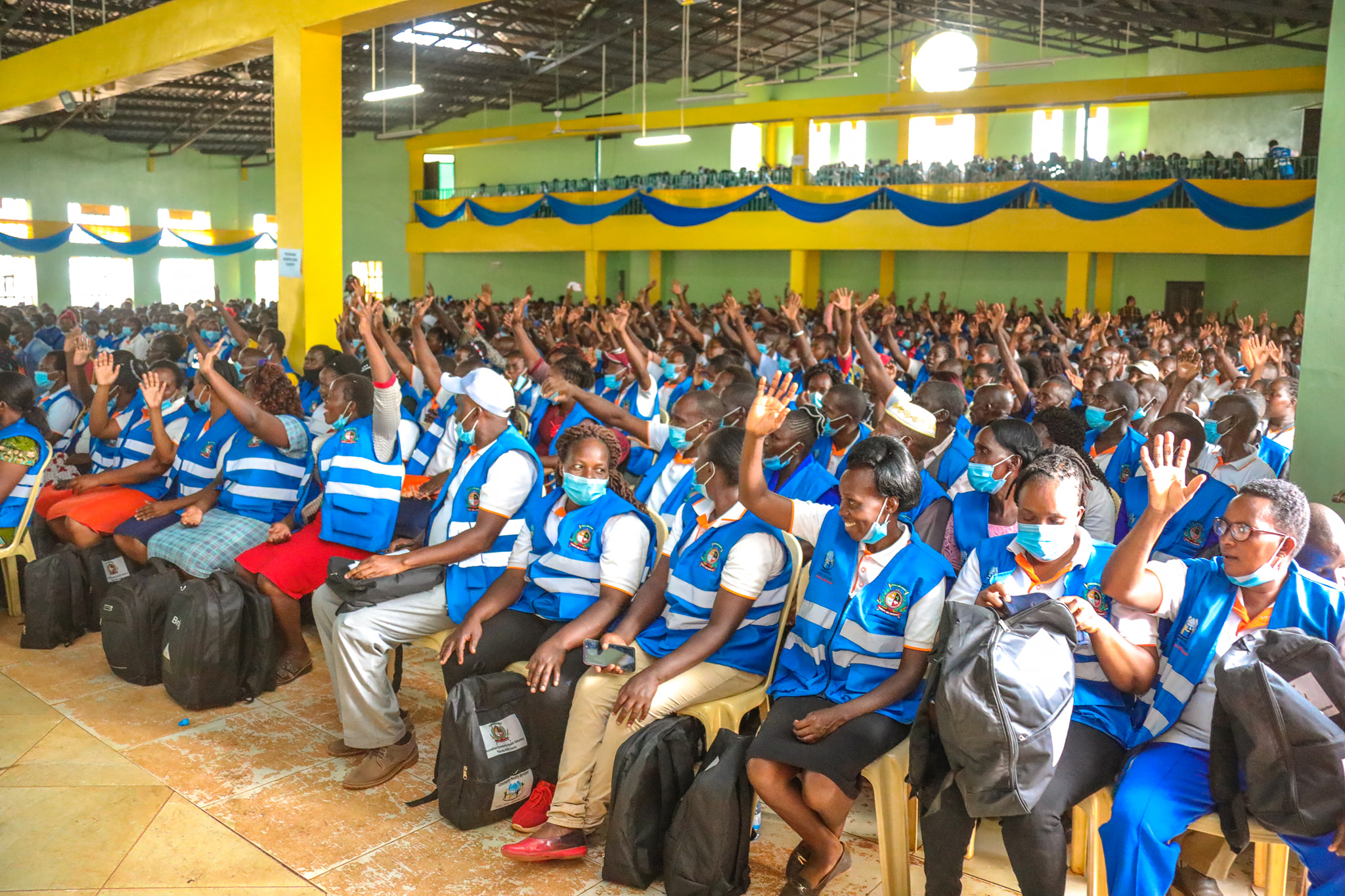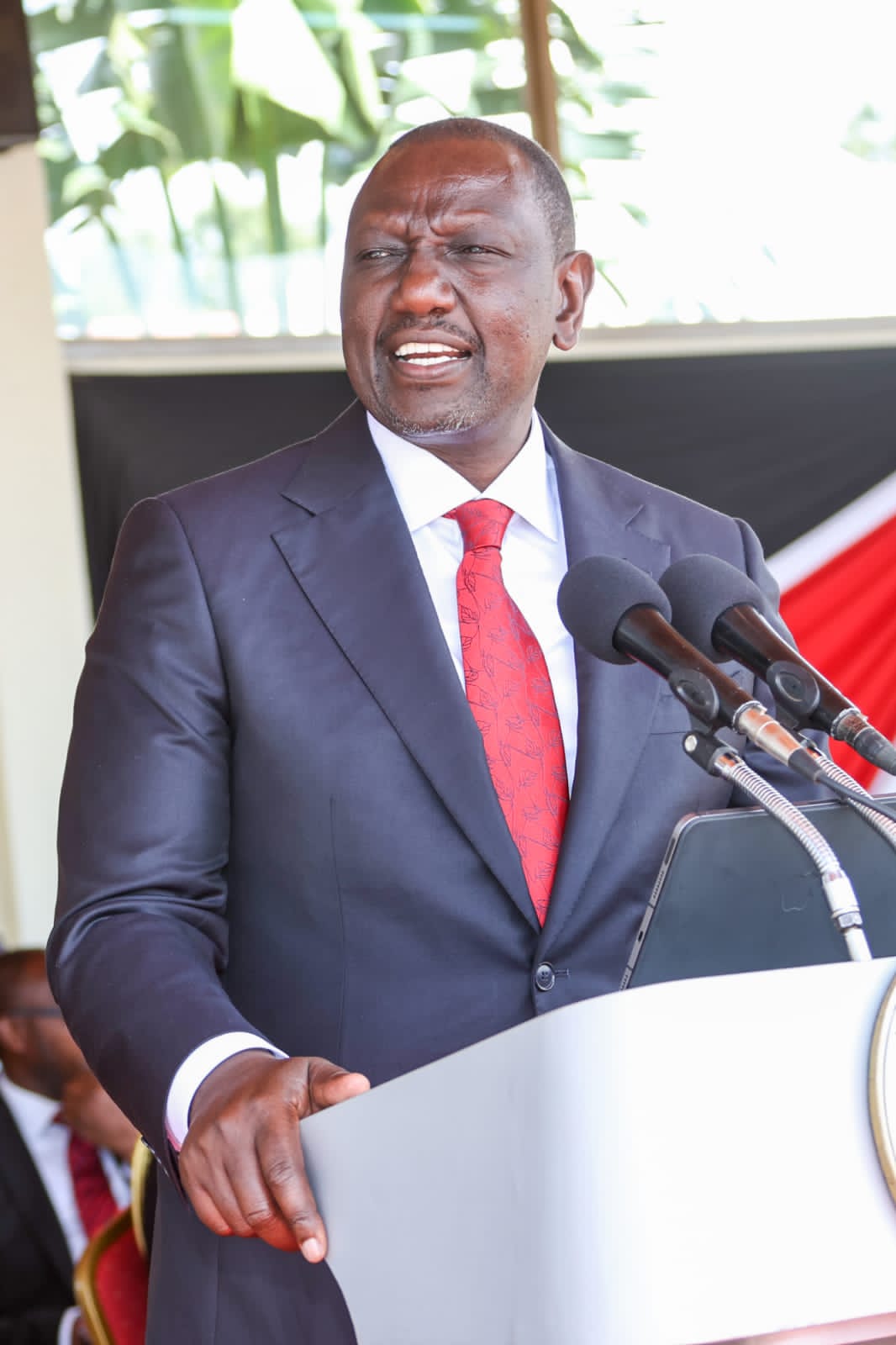In her Kandiege village in Kenya’s Homa Bay County, Loyce Anyango is held in high regard.
She is a community health promoter (CHP) and sensitizes the villagers on maintaining general hygiene as the world recovers from Covid-19.
Kenya has 47 devolved, semi-autonomous county governments headed by governors in charge of the health function.
She holds monthly meetings, and “no one wants to miss Anyango’s meetings. She has taught us a lot about our health and sometimes gives us painkillers and vaccinates our children,” says Grace Aketch.
The CHPs are crucial drivers in advancing preventive health.

Governor Muthomi Njuki of Tharaka Nithi County said equipping and empowering them is critical to achieving Universal Health Coverage (UHC), Kenya’s dream yet to materialize.
In 2018, the national government launched a pilot UHC program in four counties, with a planned nationwide rollout in 18 months.
Kenya has 47 devolved, semi-autonomous county governments headed by governors in charge of the health function. The challenge it needs to overcome is rolling out UHC under such a system.
In 2018, the national government launched a pilot UHC program in four counties, with a planned nationwide rollout in 18 months.
That did not happen, and now, a rollout is slated for later in the year, which is why CHPs are considered crucial.
Kenya still has high cases of preventable diseases such as malaria and has to deal with challenges like malnutrition and child mortality.
Anyango is aware that the government is planning to train all CHPs and give them standardized kits to enhance their medical response at the community level, and she is excited.
“These kits will make our work easier. I hope they will train us adequately on how to use them to enhance preventive and promotive care,” she said.

Governor Njuki, the chair of the Health Committee in the Council of Governors (CoG), said the comprehensive responder kit supplied by the national government will help the health workers to collect and record information daily.
“This will boost CHPs’ contribution to improving preventive healthcare instead of curative healthcare at the grassroots. This is what Kenyans need,” he said.
“The current government has learned from the previous administration’s mistakes and has put measures in place to ensure that the national rollout of UHC succeeds.”
The national government has committed to match up the monthly stipend the counties have given CHPs and cap it at a minimum of 35 dollars for the first three years.

Dr Thuranira Kaugiria, a member of President William Ruto’s advisory team on health, said the government would review the plan before the end of the three years and find a more sustainable way of remunerating CHPs.
“We appreciate that health is a devolved function, and everything the national government does is with the blessing of and in collaboration with the county governments so that we can achieve UHC together,” he said.
“As we monitor the progress of the implementation of the partnership between the national and county governments, further deliberations shall be held.”
The World Health Organization (WHO) says every country has a different path to achieving UHC and deciding what to cover based on the needs of their people and available resources.
The UHC program has four pillars – health financing, human resources for health, Integrated Health Information Management System, and health commodity security.
Kenya still has high cases of preventable diseases such as malaria and has to deal with other challenges like malnutrition and child mortality.
According to the just released Kenya Demographic and Health Survey 2022, about three-quarters (78 percent) of all deaths in the first five years of life occur during infancy (0 to 1 year), and about half — 51 percent — of all deaths occur during the first month of life.
The report was released on July 3, 2023, and it indicates that 18 percent of children under five are stunted (too short for their age), five percent are wasted (too thin for their height), and 10 percent are underweight.
The government believes it is through UHC that these disorders can be alleviated.
“County governments have incrementally funded preventive and promotive health, improved patient care and diagnostic capacity, and increased the health workforce.”
Dr Thuranira said the current government has learned from the previous administration’s mistakes and has put measures in place to ensure that the third attempt at the national rollout of UHC succeeds.
One of the mistakes, he said, was input financing, which led to an increase in the utilization of medical supplies and services that were yet to be planned for.
“The mistake of input financing is that the national government decided to buy everything without involving the piloting counties. This led to a surge of intake of health services because everybody had been told everything was free,” he said.
“The second mistake was that the piloting counties decided to reallocate their health budgets to other functions because the State was funding health.”
Kenya’s UHC program has four pillars – health financing, human resources for health, Integrated Health Information Management System, and health commodity security.
“The national and county governments should commit to supporting Community Health Promoters through better remuneration and equipment.”
Health financing has been a bone of contention between the two levels of government, with counties constantly blaming the National Treasury for delayed disbursements of devolution funds.

For Mary Mwami, the Manager of the Advance Domestic Health Financing Project at the African Institute for Development Policy (AFIDEP), the problem with UHC implementation regarding health financing is two-fold.
First, despite Kenya continuously increasing its allocated budget share to health, the allocation still needs to catch up to the 15 percent of the national budget that African governments agreed to in the Abuja Declaration.
Secondly, UHC focuses on primary healthcare, including promotive and preventive health. However, higher budgets, both at the national and county levels, still go to curative health.
“Donors are the main funders of promotive and preventive health. High government expenditure goes to governance and administration, most of which is salaries,” said Mwami during a health advocates’ meeting organized by AFIDEP and Partners in Population and Development Africa Regional Office (PPD ARO) in mid-June.

Kirinyaga governor and CoG chair Anne Waiguru said the current government allocation to the health sector is 11 percent. Still, counties have progressively increased or maintained their health allocation at 30 percent of the county budgets.
“County governments have incrementally funded preventive and promotive health, improved patient care and diagnostic capacity, and increased the health workforce,” she said in her State-of-Devolution address on June 30.
“To boost access to health services at the lowest level, county governments have recruited approximately 107,839 CHPs and their invaluable contribution is recognized through stipends.”

The contribution of community healthcare services in lessening Kenya’s disease burden cannot be overstated.
The KDHS 2022 says a CHP visited five percent of women surveyed three months before the survey.
The most common health services received or talked about during the visits are water, washing, or sanitation (43 percent), child immunization (32 percent), family planning (22 percent), and child growth or nutrition (20 percent).
“We have indeed focused on curative health for the longest time, which has, in turn, used many resources in the health department.”
Yet, according to the WHO Database 2020, up to 80 percent of Kenya’s government’s health expenditure goes to curative health.
Governor Njuki said governors must now shift focus to preventive and promotive health.
“We have indeed focused on curative health for the longest time, which has, in turn, used many resources in the health department,” he said.
“When we turn to promotive health, we are likely to reduce hospital visits and decongest our hospitals.”
He added that one of the best ways to ring-fence health funds is through the Facility Improvement Fund, which all counties should adopt.
“Thus far, 27 counties have enacted the Facility Improvement Financing (FIF) Act, and 16 counties are already implementing their FIF Acts. The other 20 other counties are in the process of having the FIF legislation enacted,” he said.
Under the UHC’s health commodity security pillar, Dr Thuranira said the government plans to leverage economies of scale and pooled procurement for medical supplies to reduce their cost for the citizens.

“Currently, KEMSA [Kenya Medical Supplies Authority] goes to the market with minimal requests from county governments.
“Envision a case where I have requests from all the private players and faith-based organizations, and I’m supplying medicine to them at lower rates. What would make them sell at higher prices than the government?” he posed.

President Ruto said his administration would collaborate with the counties to support primary healthcare and deliver UHC.
“We must work on promotive and preventive health; towards this, we will train and equip 100,000 community health promoters to achieve the ratio of one promoter for every 100 families,” Ruto said.
And for the national rollout of UHC to succeed, Governor Njuki said everyone must play their part.
“The national and county governments should commit to supporting Community Health Promoters through better remuneration and equipment,” he said.
“As the CoG and Health Committee, we are advocating for an increase in budgetary allocations to the health docket to at least 30 percent, even as we capacitate the CHPs.”
When this is done, CHPs like Anyango can provide better healthcare services at the grassroots.
_____________________________________________________________________________________
Ombogo is an editorial consultant and consulting science editor for Media for Environment, Science, Health and Agriculture (MESHA) in Kenya.
